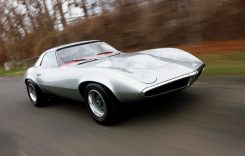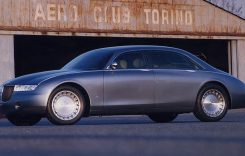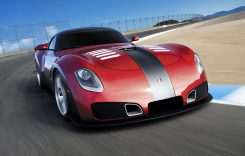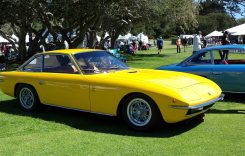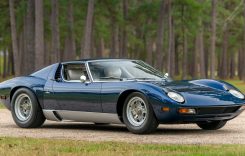Before knowing Ducati was going to introduce a touring version of its Diavel, we had already tackled the question of how it would be on long rides in our “King of the Mtn – 2012 Ducati Diavel vs Shasta” article. We love being able to travel at hyper-velocity and the way the Diavel hugs mountain roads. But its riding position locks you in place, buffeting becomes a factor at highway speeds, and the fact that it burns through a tank in a couple of freeway hours were major concerns. With an average 36.76 mpg, it means riders need to pit every 150 miles or so as maximum range borders Climb on with Motorcycle USA as we put the touring version of the Diavel to the test in our 2013 Ducati Diavel Strada Comparison video.
on 165. The lone benefit of this is at least riders get to stretch their legs every other hour.
The Ducati Diavel has created a furor since its introduction. A 1198cc Testastretta Superbike engine, Ducati’s signature trellis frame, a 240mm rear. Who’d ever heard of a so-called cruiser with traction control, variable engine mapping and Bosch/Brembo ABS? When it came out, we tested it against everything from cruisers to streetfighters to see where it fit in. Seeing how the Diavel defies categorization, it comes as little surprise that Ducati created a touring version for 2013.
Touring treatment on the 2013 Ducati Diavel Strada includes the addition of small saddlebags, a broad touring windshield, and a new shape to the seat aimed at positioning riders farther from the tank. The Strada handlebars have been pulled back a couple inches and raised 20mm compared to the standard Diavel. The Strada version gets heated grips, too. Passenger accommodations see the addition of grab rails, a backrest, and fixed pillion footpegs. The riding position feels pretty much the same but there is a little stress on the wrists thanks to the new positioning of the bars. J&P Cycles Zach Parham, who rode the Diavel Strada out to Sturgis, said the riding position was tolerable for about 300 miles before fatigue sets in from being locked in one position.
“You really had nowhere else to put your feet to even stretch,” Parham said.

Hop on the Diavel Strada and you’re more ‘in’ the bike compared to the Rocket III, legs tucked, body leaning slightly forward. Even though its seat height is higher than the Triumph’s according to the spec sheet (29.5 in. on the Rocket III Roadster compared to the Diavel’s 30.3 in.), it’s easier to get two feet firmly planted at stop on the Diavel thanks to the taper of its tank. The motorcycle uses a key fob to enable the bike’s ignition system, the key needing to be within 6.5 feet of the bike for it to function. Accessing the bike’s on/off switch is a pet peeve as the button is mounted on the tank console below the speedo/tach instrument display with barely enough room to squeeze in chubby gloved fingers. But once the bike goes through its systems check and fires up, the rumble of the Diavel’s dual megaphone exhaust is intoxicating. It’ll make you drunk with power and long to rev it to redline just to hear the L-Twin roar.
Crack the throttle of the ride-by-wire system and you’d better be holding on tight because just after 3000 rpm a surge of torque is coming on strong. The engine pulls top to bottom, staying above 70 lb-ft at 3500 rpm all the way up to its peak output of 81.95 lb-ft at 8200 rpm, while its horsepower stretches out even further to 9500 rpm before hitting its gaudy 137.55 hp plateau.
“The Diavel’s engine is totally unique in the ‘cruiser’ realm. What cruiser can you pop up the front end without so much as a shrug? It’s not fair really, with insane performance in every regard. Immediate power, yet easily controllable,” said fellow tester, Motorcycle USA Managing Editor Bart Madson.
This control is due in part to the Ducati’s three variable engine maps and eight levels of Ducati Traction Control (DTC). Riders toggle through the three Riding Modes via switchgear on the left handlebar, with Urban Mode good for inclement weather as it cuts power to 100 hp and ups the DTC to Level 5. In Touring Mode, riders still get all of its claimed 162 hp but it builds a touch slower than full Sport Mode, its DTC dropped a tad to Level 4. In Sport Riding Mode, riders get instant access to all 162 hp while DTC lowers to Level 3. The DTC is factory pre-set for the three riding modes, but can be customized by riders through the set-up menu.

The result is power that’s immediate but controllable. Give the Diavel’s throttle an aggressive twist in any of the first three gears and the front tire will loft with ease. The ride-by-wire system is quick and responsive. Hit your shift points and it can go from 0-60 in 3.26 seconds. But it is a bike that begs to be on the throttle because the Diavel Strada gets a little rumbly if you let it drop down in the rev range and fuel delivery gets choppy between 2000 – 3000 rpm.
The six-speed gearbox on the Diavel is a little rough around the edges, too. The clutch lever pull felt lighter than the Triumph but the gears are notchy and we experienced a handful of false neutrals. The “thunk” into first gear is particularly loud and mechanical. Fortunately, engagement of the straight cut gears above that smoothens out a bit.
Heading out on our favorite twisted testing grounds, the Ducati Diavel Strada demonstrates its biggest advantage over the Rocket III Roadster. Handling is much lighter by the sheer fact that there’s less mass to deal with as there’s more than a 300-pound difference between the two. The compact rider’s triangle and tucked-in leg positioning helps in controlling the bike and allows for generous cornering clearance. Handling is neutral but turn-in requires a little effort because of the massive 240mm chunk of Pirelli rubber on the back. Once leaned into a turn, the Diavel Strada is ultra-stable and fluid with the Diablo Rosso II tires offering up an impressive amount of grip. While a lot of pushing and pulling on the bars of the Rocket III is required to get it properly lined up, the Diavel Strada requires much less input. What Ducati has achieved with the bike’s handling considering the garish proportions of the rear tire is impressive.

The brakes on the Ducati are also impressive, combining incredible stopping power with precise modulation. Big twin 320mm discs on the front with radially mounted Brembo monobloc calipers get the job done with an aggressive bite, the action easily discernible at the lever. Add ABS to the equation and the Diavel can be ridden at an aggressive pace because of the confidence two-finger stopping instills. Madson said the “brakes on the Ducati have no equal in the cruiser realm.”
The Diavel Strada also has distinctive split-level instrumentation, with an upper LCD display and a lower Thin Film Transistor (TFT) panel. The TFT on the Diavel senses the amount of ambient light to decide whether to display the background color in black or white. Between the two displays, there’s a slew of information displayed, from engine modes to DTC levels, odometers to miles-per-gallon averages. With so much information, rifling through its various menus does require a learning curve. Managing Editor Madson also made an astute observation about the instrument arrangement.
“The lower display, inset in the tank area, is gorgeous, with its vibrant colors and backgrounds easy to read. The second display, resting above, looks good too, with its digital speedo and horizontal tach reading. And there’s a host of information on tap, including the prominent gear position indicator. That’s the good news… But there’s no fuel gauge! It boggles the mind when riders can access effectively useless information on the bike’s dash – instant miles-per-gallon being particularly worthless – but not see how much fuel is in the tank. Instead the fuel light comes on, indicating you have entered the reserve gallon and there’s 30 miles, give or take, to empty. That came about eight miles short for me on one ride,” he said. This issue caused Madson to run out of gas while testing.
As far as the Strada’s touring treatment, the windshield deflects air from a rider’s chest but the head is still subject to buffeting. The bags are small with a 10.8-gallon capacity and the zippers are cheap. While unloading the bike, we busted one of the zippers fairly easily, rendering the bag virtually useless. They don’t lock, either. The position of the bags actually made it harder for a passenger to climb on, too, because they have to swing their legs way out to get over them. But our biggest gripe is range. We got 132.6 miles out of the 4.5-gallon tank before running out of gas in the middle of nowhere. For a bike that’s supposedly set-up for touring, this equates to gas breaks almost every other hour if you’re running it hard.
Don’t get us wrong. The Ducati Diavel is an amazing machine, with a beast of an engine, top-notch stoppers, and rider aids that make it very forgiving. But beyond the more comfortable riding position, the new windscreen is only modestly effective, the bags are lackluster, and range hasn’t been improved on the touring version. If you like getting to your destination in a hurry though, the 2013 Diavel Strada is an E-ticket ride at Disneyland.
